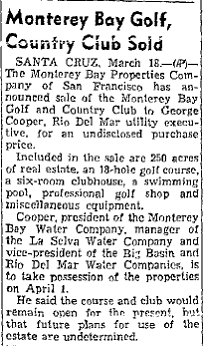Now for the rest of the story.
Shortly after the course opened, Rispin was thrown into bankruptcy. The course and other unencumbered properties were purchased by his partner, Robert Hays Smith. He put his son Nicol on the payroll as manager of the course.
The Smiths appeared in the society pages with some regularity; wife Susan for example appears in a short list of participants in an informal tournament held at Cypress Point November 1931. Her name appears second to last, right before Marion Hollins. Nicol Smith would gain local fame as an explorer (in press accounts he assumed a shorthand, career-encompassing sobriquet: "explorer-lecturer-author") -- and for marrying a Standard Oil heir in a Georgetown, DC, society wedding in 1938. (Childless and essentially abandoned, Moira Archbold Smith would ask her husband for a divorce in 1952, and he would grant it.)
But even as the society page notices continued through the 1930s, Smith's financial difficulties mounted in 1933, the year of the most-severe banking crisis in national history. Smith declared bankruptcy in 1936, forfeiting the Rispin Mansion, the star-crossed Monterey Bay Golf & Country Club, and a number of other properties.
At this point the Prescott family took over the course, adding golf to horseback riding, swimming and other outdoor activities available on offer at the Prescott Inn. For the next six years the course belonged to the Prescott Inn. Dale Barick, who won a Northern California championship, served as pro for a tenure of unknown duration during this period.
If the story of the owners of Monterey Bay was characterized by progressive financial diminishment, the course itself slowly was squeezed, too, victim of inexorable development. According to Carolyn Swift, the Prescotts presided over a "smaller" course.
And then in 1942, they sold to a representative of the Rio Del Mar company, as reported in the March 18 Oakland Tribune:

Although Rio Del Mar had built a golf course as part of its development in the nearby community of Aptos, the company's uncertain intentions read ominous indeed for the future of the course.
The end came in the 1960s. Monterey Bay Golf & Country Club is now Monterey Bay Heights. Other than the clubhouses (one serves as a nursing home), the only hint a golf course once lived there can be found in the unintentionally ironic habit of developers to names streets after the very things they killed to develop: Fairway and Putter drives, Tee Street, Ball Drive.
And Hardin Way!
Mark